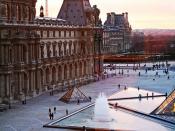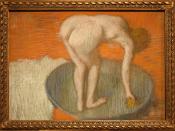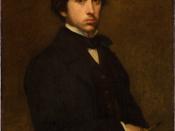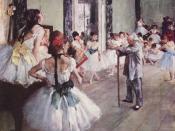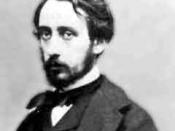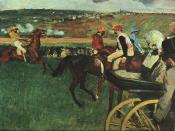Amber Ware 10/18/2002 THE LIFE OF HILAIRE-EDGAR DEGAS I was born the nineteenth of July in 1834, at Eight Rue Saint-George in Paris. My father was a French banker named Pierre Auguste Hyacinte, and my mother was a wealthy Colonial American from New Orleans named Celestine Musson. My family wanted to sound more aristocratic so they changed my family name from Degas to De Gas; this showed a name derived from land holdings. Although in 1870 I changed my name back to the original form. I started elementary school in 1845 at Louis-le-Grand. Tragically my mother died in 1847 when I was 13 years old. My father and I were alone for the first time.
In 1853 I graduated from High School. I began to have an interest in art, so I gave up my law studies to study art. I started attending assiduously Louvre and "Cabinet des Estampes", at "BibliotheQue Nationale".
A room in my house was turned into a studio for me to do my work. First I studied the work of Felix-Joseph Barrias, and then I became a pupil of Lois Lamothe in 1854.
I then received permission to copy paintings at the Lourve in Paris. In the nineteenth -century artist copied paintings by old masters in order to develop their own skills. While I was growing up I admired Jean Auguste Ingres and his great art using his memory for drawing.
I began to realize how much I loved art. I traveled to different places to study these arts and discovered many new things. I started my artistic studies with Louis Lamothes, a pupil of Ingres; he stressed the importance of drawing from memory. I started classes at the Ecole des Beaux Arts. I left in 1854 to go to I Italy for 5 years. While I was there I studied the Italian art, especially those of the Renaissance. I returned to Paris in 1859 painting portraits of family and friends. In 1855 I met the man I admired the most, Ingres, my favorite artist.
In 1860 I was painting racehorses and visited the races often. In 1868 I finally began getting recognition as an artist. Ballet had caught my interest and many of my paintings consisted of ballerina's.
On July 19, 1870 the Franco-prussian War begins, and I volunteered for the National Guard. The commune lasts only two months. My eyesight also started giving me problems.
My opera ballet paintings continue through 1871. I went to Louisiana with my brother Rene in 1872 to visit relatives that were in the cotton business. While I was there I painted The Cotton Exchange at New Orleans.
This was my only picture to be acquired by a museum in my lifetime. In 1873 my painting Woman Ironing was my first painting sold. The buyer was Durand-Ruel, an art dealer.
After returning to Paris I started attending the impressionists at "Café de la Nouvelle Athenes" and returned to my studies on dancers, washers, ironing maids and began the one on milliners. I started experimenting with pastel colors. My art appeared in all but one of the eight impressionist exhibitions between 1874 and 1886.
In 1874 my father past away and left me in a lot of debt. My brother Achilles' borrowed 40,000 francs from me to start a New Orleans business. It failed so in 1876 the creditors were threatening to sue me. To uphold the family name, my brother-in-law and I settled the debts through our own pockets, sacrificing most of our personal fortunes. I sold my house and my priceless art collection.
My eyesight is getting continuously worse. In the late 1870's I met a girl named Mary Cassett. She had the same interests as I did, so we got along great. I taught her much of my knowledge about art. I would have married her, but I could never make love to her.
Pastels became my preferred medium in the 1880's. My good friend Manet dies and I have a hard time dealing with it.
At age 59, I perform my one and only one-man exhibition at "Durand-Ruel Gallery". I show many pastels.
In 1894 Dreyfus, a Jewish army officer, had been convicted of spying and sent to Devil's Island. When they realize an injustice could have been committed the French people divided into two camps, and they reopened the case. I broke with Jewish and liberal-minded friends of long standing and the eventual freeing of Dreyfus only served to upset me further.
In 1912 I was forced to move away from my Rue Vicor-Masse studio because of my financial situation. I moved to "Clichy Boulevard". This along with my failing eyesight and bad health brought my art life to a halt.
On September 27,1917 at the age of 83 I died a lonely man in Paris.
